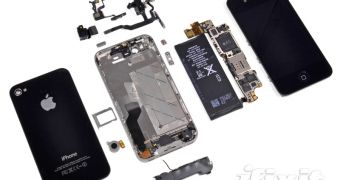Market intelligence firm IHS iSuppli is running an analysis on the iPhone 4S that pinpoints key changes between the new model and the ones before it. The firm promises to come back with its own teardown analysis too.
Their analysis illustrates “key changes in the product’s feature set and component selection,” despite the fact that much of the media coverage cited immense similarity to the iPhone 4.
“Important differences include a major upgrade to the apps processor, the use of a higher-resolution and more advanced camera module, and the addition of a new cellular radio that makes the iPhone 4S a true world phone,” according to Wayne Lam, senior analyst at IHS.
The report is titled "iPhone 4S Shows Key Design and Component Changes". Yet none of these upgrades spell design changes per say, if we’re to consider the primary definition of the word.
In fact, the lack of design alterations of the iPhone 4S has been the subject of much debate lately.
However, if we’re to denote how the phone looks on the inside, the ‘design’ has indeed changed quite a bit.
For example, iSuppli highlights the new dual-core apps processor, and the five-lens camera module with an 8-megapixel sensor and backlighting.
All these things are noticeable only after a thorough teardown of the device. One such teardown has already been peformed by the tinkerers at iFixit.
iSuppli continues with its analysis and outlines that the iPhone 4S merges the HSPA and CDMA radio capabilities previously found separately in different iPhone models.
They note the new Qualcomm baseband chips, and the use of three different power amplifier module (PAM) module suppliers.
The company also looks at how Apple managed to get away with using just 512MB of RAM, by optimizing iOS to need as little memory as possible, enabling the company to save costs.
“The use of this low density of memory highlights the efficiency of Apple’s iOS operating system compared to those of competitive smartphones, which use twice as much SDRAM, at 8Gb,” (gigabit) says iSuppli. “This lowers the cost of this memory subsystem, leading to greater design economy relative to alternative phones.”
The firm promises to reveal the results of its full physical teardown in the near future. The report aims to provide actual data on iPhone 4S components and features, and will likely include an estimated bill of materials (BOM).

 14 DAY TRIAL //
14 DAY TRIAL //